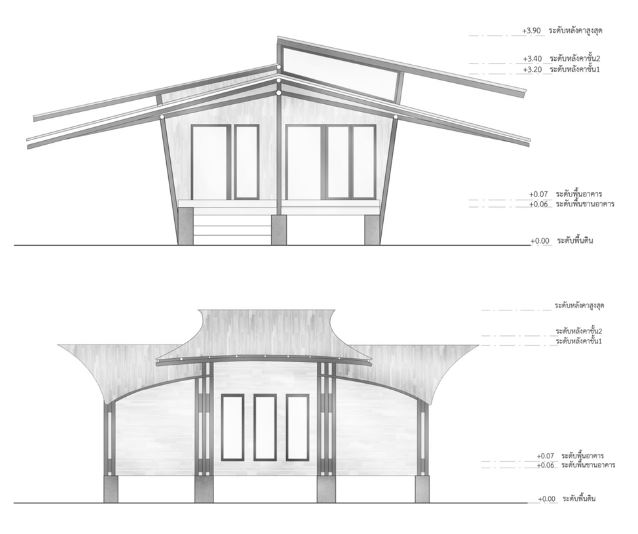Structural Capacity of Columns using Bamboo culms from species in Thailand
Keywords:
bamboo architecture, column, species, sustainabilityAbstract
Bamboo has played more and more significant role in modern day architecture because of its sustainable contribution, and also simply responds to the UN’s Sustainable Development Goals. To promote more uses, bamboo still is uncertain for architects and designers on structural capacity. Bamboo architecture have been created by playing safe using over-structure or making a rough estimate. It should be important to design structure more precisely and properly. This research is the experimentation of using bamboo in column application. It is distinctive that bamboo architecture is quite different from typical structure using post and beams. Bamboo structure can be unclear on whether it is post or beam, rather they are truss frame. Then column design will become a critical factor. This research then looks into the column capacity of 5 Thai bamboo species. They are all species that mostly use for structural applications in Thailand. They were measured for physical properties, and tested for structural capacity in compression loads. The result show that they have various sizes that affect the structural capacity directly. Interestingly, most of them have relatively similar thickness. The test obviously confirms the bigger culm can receive more load. It showed that D.Giganteus can receive the most load, due to its sizes, and B.multiplex offered the least load. However, when formulating test result into per unit of section area and diameter, D.sericeus can received the most compression. In overall per unit section area, Dendrocalamus family perform better than Bambusa family. Moreover, when calculating compression load in unit diameter, it is also interesting that all species can relatively receive similar load per centimeter of culm diameter. In conclusion, it is confirmed that sizes of culms are proportioned to compression capacity, and if size is not the factor, Dendrocalamus family is doing better than Bambusa family. The research still uses computer model to calculate the applicability of bamboo column strength, and four species are working, except B.Multiplex. In that case, bundling with more culm can be further investigated. The benefit to this research is to promote more proper uses of bamboo species in column application, and as well promote to have more sustainable architecture.
Downloads
References
Bamboo House. Suan Pai Ngam Prachinburi. Retrieved from https://www.nanagarden.com/shop/25304
Bamboosaurus. (2018). Meditation center. Retrieved from https://bamboosaurus.com/?page_id=764
Chantawongse, S. (2014). Mechanical Properties of Dendrocalamus Asper for Structural standard to use in Public Building, Master Degree thesis, faculty of Architecture and Planning, Thammasat University, Thailand
Fan H., & C. Fan. (n.d) Test Method for Determination of Mechanical Properties of Bamboo. Harbin; Civil Engineering and Architecture Harbin University.
ISO. (2004). Bamboo-Determination of Physical and Mechanical Properties. ISO 22157-1: 2004(E). , S witzerland; International Organization for Standardization.
Malanit, P. (2009). The Suitability of Dendrocalamus asper Basker for Oriented Strand Lumber. Doctor of Philosophy’s thesis, University of Hamburg. Hamburg.
Pongthana, P. (2014). Study of Structural capacity of Bamboo Bundling, Master Degree thesis, Faculty of Architecture and Planning, Thammasat University, Thailand
Rittironk, S. (2019). Mechanical Properties of Thai Structural Bamboo species to be used in Sustainable Architecture, Proceedings the 10th International Academic Consortium for Sustainable Cities (IACSC) 2019, Yokohama City University and Hasanuddin University.
Rittironk, S. (2019). Mechanical Properties of Thai Structural Bamboo species for Sustainable Architecture of Tropics, The proceedings of the 1st international conference of Future of Coastal Cities (FCC) 2019, Qingdao University of Technology, Qingdao, China, October 16-17, 2019.
Rittironk, S. (2011). Thai bamboo: Material Explored, G7 Publication, Bangkok, Thailand
Nienhuys, S. (2012) Thin Bamboo Culms For Trusses-Use of Two and Three Culms in Composite Beams. Retrieved November 17, 2012. from http://www.nienhuys.info
Thaipetch, S. (2004). Physical and Mechanical Properties of Five Bamboo Species in Thailand. Final Technical Report: Sustainable Management and Utilization from Bamboo. Royal Forest Department, International Tropical Timber Organization, Bangkok, Thailand, pp. 41-45
United Nations. (2019). Transforming Our World: The 2030 Agenda for Sustainable Development
Unjaijom, T. (2017) Mechanical Properties of Five Species Dried Bamboo. Srinakharinwirot Engineering Journal, 12(2): September – December, pp. 8-14

Downloads
Published
How to Cite
Issue
Section
License
Copyright (c) 2019 International Journal of Building, Urban, Interior and Landscape Technology (BUILT)

This work is licensed under a Creative Commons Attribution-NonCommercial-NoDerivatives 4.0 International License.











